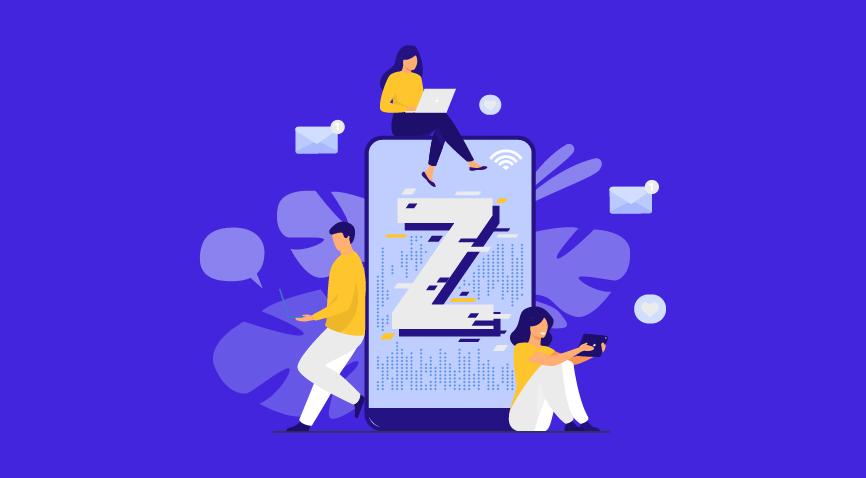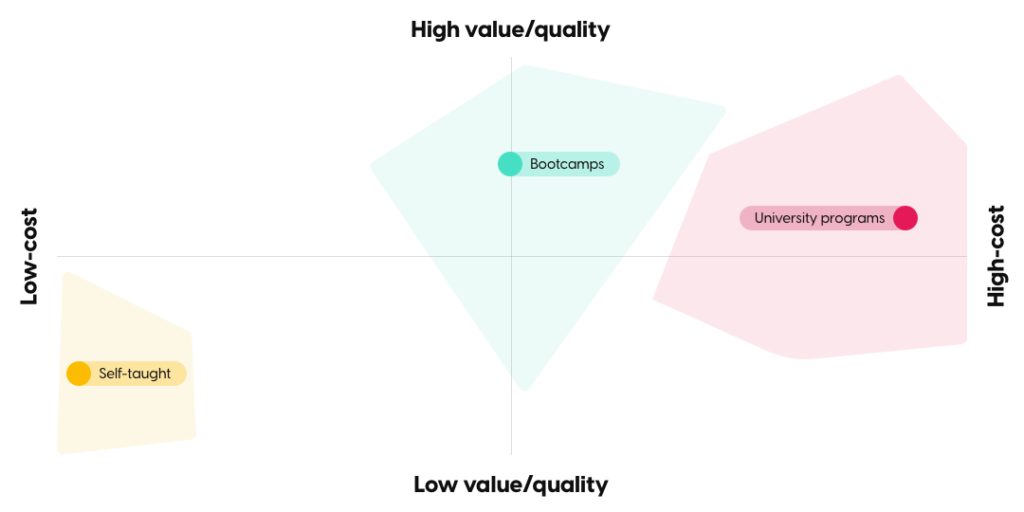
Table of Contents
- Introduction
- What is UX Design?
- What Does a UX Designer Job Entail?
- Who Can Become a UX Designer?
- UX Design Tools You Need to Master
- How to Get into UX Design?
- How to become a UX designer with no experience in 8 steps?
UX designer is the new obsession in the world of websites, apps, and products. And for a good reason too. But is it a lucrative career? How do you become a successful UX designer? What skills do you need to develop to become a UX designer? Let’s answer all these questions and then some in this blog.
What is UX Design?
UX, the abbreviation for User Experience, is the process of making any product digital or physical, useful, relevant, and meaningful for the people using it. It is an ever-evolving and ever-expanding field, wherein you are expected to continually improve your design of the product to get your users happily engaged with it.

What Does a UX Designer Job Entail?
As a UX designer, your goal is to understand your users’ wants, motivations, and issues thoroughly and then create experiences and processes to address them. A high-level overview of the user experience process would be as follows:
- Spend time learning as much as you can about the issue you’re attempting to fix.
- Make low-fidelity wireframes to brainstorm different solutions to the problem.
- Convert those wireframes into ‘user flows,’ which are pathways that guide users through the whole process.
- Ensure that the designs are functional, relevant, and engaging by testing them.
- If you’re pleased with the experience, move on to make it more aesthetically appealing and consistent with the rest of your designs/app/site.
Who Can Become a UX Designer?
There are no hard-and-fast rules on becoming a UX designer; they come from various walks of life. Anyone can become a UX designer (we’ve heard of project managers, sales representatives, and even dentists making the switch to UX!) You can learn the technical skills of the UX design process over time.
According to a Digital Skills Survey, 65% of UX designers started their careers in design before concentrating on UX design to get a competitive advantage in the job market.
What Skills do You Need to Become a UX Designer?
UX design involves considerable technical skills, including, but not limited to, user research, information architecture, wireframing, prototyping, and usability testing.
One skill you definitely don’t need to become a UX designer is coding (not at first, at least). Here’s what you do need to learn:
1. Research
UX designers need to know what their consumers desire and how they see the world in order to do their jobs well. According to UXmatters, this entails acquiring the capacity to design, conduct, and analyze data from various research approaches. User testing and analytical research skills are very beneficial.
2. Information architecture
Information architecture is the process of structuring data in a logical, intelligible, and cohesive way. Information architecture may be found on websites, applications, software, printed documents, and even physical venues. It includes systems such as labeling, navigation, and search tools.
3. Wireframing
A wireframe is a sketch for each interface screen. Its primary goal is to demonstrate how something works rather than how it seems. The elements that must be present from page to page are defined by wireframing. It contains all of the necessary interface components for all potential interactions and is often created in grayscale with boxes and lines.
4. Prototyping
UX designers use prototypes to test functionality. They assist designers in ensuring that a system and its users are compatible before the final product is built. Designers may use prototypes to evaluate page functionality as well as overall navigation. The UX designer may go through numerous iterations as difficulties are uncovered before settling on a design that fits both the business and the goals.
5. Visual communication
UX designers must be fluent in visual language because the field is itself is extremely graphic in nature. Visual communication proficiency entails a comprehension of topics such as:
- Layout
- Colour
- Typography
- Icons
- Images
- Design theory
Beyond these, ‘soft’ skills like communication and critical reasoning are just as important. The technical skills of the UX design process may be learned through time. However, you should ask yourself: What ‘soft’ talents and motives fuel your interest in UX design at this early point?
- Curiosity and critical thinking: Do you find solving business challenges thrilling and wish to work in an ever-evolving, fast-paced environment?
- Empathy: Do you enjoy conversing with individuals and attempting to comprehend their needs?
- Creativity: Are you a professional artist who is sick of receiving unduly subjective feedback? (For example, are you a graphic artist who is fed up with being told to ‘make the blue less blueish’?)
- Collaboration and Communication: Do you thrive in a team-oriented setting?
Empathy, curiosity, creativity, and collaboration/communication are UX design foundations. Many of them are talents you already have or have acquired through your present job!
UX Design Tools You Need to Master
To create winning user experiences, UX designers employ an array of tools. These include a broad range of wireframing tools, the most popular of which is Sketch, but others include Illustrator, InVision Studio, Adobe XD, Axure, Figma, and Marvel. Photoshop is a great choice for interface design, and any designer should be familiar with it.
InVision is the most popular prototype platform; however, Sketch is also a popular choice. Principle, Flinto, Framer, and ProtoPie are some tools available for advanced prototyping, including testable models with micro-interactions.
The first step in becoming a UX designer is recognizing what abilities you already have and which ones you need to develop. So, where do you go to get the talents you’re missing right now?
How to Get into UX Design?
The three typical UX designer career paths: Pros and Cons of each
The three typical UX Designer career paths start from the way you approach the field and learn the trade’s tropes.
- Self-learning: There are more than a handful of self-taught UX designers out there – some more successful than the others. But just like any industry, without proper guidance, the scope for growth is limited and requires more time and effort on your end.
- University programs and courses: Admittedly, one of the best learning methods is from experts. And university programs and courses let you learn from professors who have dedicated years to this domain. In India, some IITs also offer PG programs in UX designing.
Acquiring a University degree in UX designing is time and money-intensive.
- Bootcamps: Boot camps are rigorous training courses that combine theory and practicals. They are usually around four months long and involve real-life projects. They cost less than university programs but considerably more than self-learning from YouTube and the likes.
Here are some of the essentials for a successful UX Bootcamp:
- There is an in-depth training on all UX and UI fundamentals (many courses skim over UI design or don’t go deep enough to be practically useful).
- Mentors from the industry provide you with frequent feedback (at least weekly, but ideally more).
- Class sizes are kept as low as possible (a maximum of 15-20 students).
- The opportunity to create a one-of-a-kind UX portfolio comprising your own case studies (not just pre-canned projects that everyone in the cohort works on).
- The boot camp is tailored to your experience and talents (for example, if you’re a graphic or visual designer or come from an entirely different field).

How to become a UX designer with no experience in 8 steps?
Learning how to become a UX designer takes time. But every now-great designer started from square one.
Even if you have little to no experience with this significant career change, there is a well-worn road you could tread.
In 2022 and beyond, this is how we would pursue a career in UX design:
Step 1: Immerse yourself in the field of UX design. Subscribe to blogs, channels, and pages to stay updated on the industry developments.
Step 2: Gain a thorough grasp of the user experience process.
Step 3: Become familiar with the most prevalent UX techniques and tools.
Step 4: Decide how you want to approach the field: whether to go to Bootcamp or university or self-learn.
Step 5: Create a UX portfolio that includes work that you are passionate about.
Step 6: Master the art of communicating your ideas.
Step 7: Develop a network with other designers.
Step 8: Create a narrative to help you land your ideal UX job.
Key Takeaways
- UX design is a lucrative career for those who are passionate and driven.
- Start by getting a bird’s eye view of the scope and learning about the aspects that interest you the most.
- Enroll for a Bootcamp or University degree or start learning by yourself – as you see fit.
- Develop the soft and technical skills and continually polish them to stay up to date.
- Create a portfolio and craft a narrative that sets you apart from the crowd, making you the ideal candidate for UX designer jobs.
Conclusion
To become a UX designer, there are numerous paths you can take. However, the best thing you can do to begin your adventure is to simply begin. Learning the principles of the UX process and building a portfolio of outstanding products will land you your first job, but that’s just the tip of the iceberg. All the best on your deep-diving journey in this ocean!
FAQs
In as little as ten weeks, you may gain the skills required to become a UI Designer. Many online courses promise that you may become an employable UX designer in 4 to 6 months.
Develop a portfolio and craft your story to start your journey of a successful UX design career. Even before you start applying to UX designer jobs, a solid portfolio – not necessarily one with more variety and more projects – is important. Your portfolio should be a genuine reflection of who you are and what you are bringing to the table. Be personal and authentic.
Latest Blogs
Explore how Google’s 2025 AI search updates triggered ranking chaos. Learn actionable strategies to adapt your SEO for AI Overviews, zero-click searches, and SERP volatility. Stay ahead now.
Learn how to rank on AI search engines like ChatGPT, Perplexity, and Gemini by optimizing your content for authority, structure, and relevance. Stay ahead in AI-driven search with this strategic guide.
Explore the best healthcare SEO services for your medical practice. Improve online visibility and effectively reach more patients in need of your services.
Get your hands on the latest news!
Similar Posts

Design
7 mins read
15 Best Firms Offering Design Services in India

Design
5 mins read
All You Need to Know About Data-Driven Design

Design
6 mins read